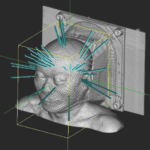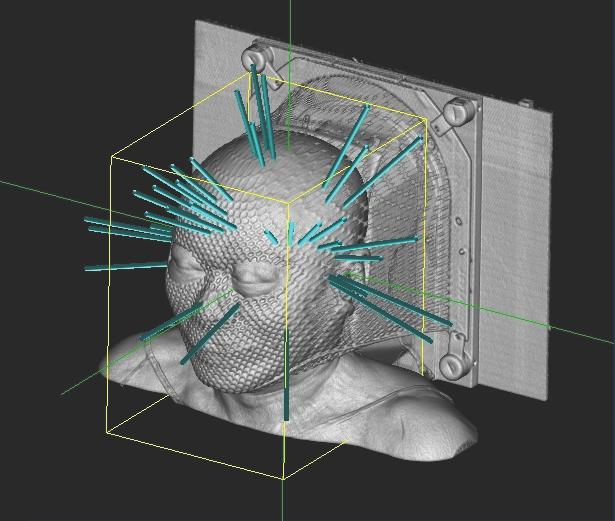 “Often, we start with the CyberKnife because it has the least risk involved and the least side effects as well.” ~ Dr. David Roberge, head of radiology oncology at Hôpital Notre-Dame du CHUM.
“Often, we start with the CyberKnife because it has the least risk involved and the least side effects as well.” ~ Dr. David Roberge, head of radiology oncology at Hôpital Notre-Dame du CHUM.
The Hôpital Notre-Dame in Montreal, Canada, hosts a monthly clinic for patients with trigeminal neuralgia, a debilitating nerve disorder, that causes “electric” pain in the face. Eating, teeth brushing, shaving or simply a light gust of wind can trigger pain. In 2012, an 89-year-old male patient suffering from trigeminal neuralgia presented to the clinic with pain on the left side of his face. The patient had undergone medical treatment, most recently with oxcarbazepine, which proved ineffective and caused him to be dizzy and unstable when he walked.
CASE STUDY: CHALLENGE
Provide non-invasive treatment of trigeminal neuralgia in an elderly patient who was unresponsive to an initial medical treatment. Invasive surgical procedures presented increased health risks due to the patient’s age.
SOLUTION
The CyberKnife System with Synchrony® Skull Tracking™ is a non-invasive treatment that administers a high dose of radiation to a specific target area, limiting exposure to surrounding tissues.
CYBERKNIFE TREATMENT RATIONALE
While being treated at the clinic, the patient was seen by a radiation oncologist and neurosurgeon to discuss treatment options. According to Dr. David Roberge, head of the department of radiology oncology at Hôpital Notre-Dame du CHUM, options available at the hospital (beyond changes to medication) included microvascular decompression (MVD), percutaneous radiofrequency rhizotomy or radiosurgery using the hospital’s CyberKnife System.
Typical surgical risks for any open-skull neurosurgical procedure, such as MVD, include infection, excessive bleeding, spinal fluid leakage and the risks of anesthesia. Percutaneous radiofrequency rhizotomy carries a greater risk of minor to severe post-surgical numbness, and can often be permanent.
In view of the patient’s age and active lifestyle, radiosurgery was preferred because it was the least invasive. Together the patient and physicians determined that the option with the best therapeutic ratio would be radiosurgery using the hospital’s CyberKnife System.
The Hôpital Notre-Dame uses the CyberKnife System for treatment of trigeminal neuralgia patients who have failed prior medical or surgical treatments or who cannot tolerate their medication. The non-invasive, outpatient procedure “delivers a single high dose of radiation directly to a short segment of the trigeminal nerve, 2-3 mm from the brainstem,” Dr. Roberge explained.
“The CyberKnife® System provides patients with added comfort when compared with other systems because it does not require that patients, who are already experiencing facial pain, be immobilized using an invasive head frame pinned to the outer surface of their skull.”
For the radiosurgery team at Hôpital Notre-Dame du CHUM, “the CyberKnife System provides the most straightforward workflow and the greatest targeting assurance compared with other non-invasive systems—giving us confidence that radiation will be delivered to the right target area every time,” Dr. Roberge said.
TREATMENT PLANNING
The actual treatment process took place over the course of two days. Once the CyberKnife option was decided, the patient came to the hospital to have his mask made and to undergo a treatment planning MRI and CT scan. After this appointment, the radiation oncologist proceeded with target volume delineation and one of the radiosurgery team’s medical physicists designed a treatment plan using the CyberKnife MultiPlan® Treatment Planning System. The entire team reviewed the plan with the neurosurgeon before the patient returned for treatment. For trigeminal neuralgia patients, the physicist also performed a patient-specific quality assurance on the CyberKnife System before treatment. “Doing treatment planning on a different day than the treatment delivery gives physicians time to collaborate, review the plan and make necessary changes without the pressure of having a patient waiting for treatment in a head frame,” Dr. Roberge stated.
TREATMENT DELIVERY
The patient was treated with the CyberKnife System in March 2013. A prescribed dose of 80 Gy was delivered in one fraction—the highest dosage the hospital gives in a single treatment. Synchrony® Skull Tracking™ was used during treatment delivery to track the target area and automatically correct for translational or rotational target shift. The actual radiation delivery took a little more than 15 minutes and the entire process lasted less than 45 minutes from greeting the patient to his departure.
OUTCOME AND FOLLOW-UP
According to Dr. Roberge, no imaging follow-up is required for trigeminal neuralgia patients. After CyberKnife treatment, patients return to the hospital for regular follow-up. They are monitored for pain control and toxicity which could be indicated by facial numbness. Then, medications can be adjusted in partnership with the referring neurologist. The patient returned to the hospital for his first follow-up two months after his treatment and reported that he was completely pain-free. The patient no longer needed medication and remained pain-free for the rest of his life.
TRIGEMINAL TREATMENT IN MIAMI
Painful Trigeminal Neuralgia is among the treatments we do the most at CyberKnife Miami. Our radiation oncologist Dr. Mark Pomper says, “Often it only takes one treatment session for the pain to go away, allowing patients to live pain free without medication. Should the pain come back, which is rare, we can safely treat it again.”
If you’re interested in finding out if our highly experienced team can help you put an end to facial pain, call us at 305-279-2900. We’ll let you know one way or another.
You can also go to our website now to learn more about how we treat trigeminal neuralgia: Here’s the link: https://www.cyberknifemiami.com/trigeminal-neuralgia/
And here’s a link to the study and treatment plan by The Hôpital Notre-Dame
https://www.accuray.com/case-studies/the-cyberknife-system-offers-alternative-treatment-for-trigeminal-neuralgia/

